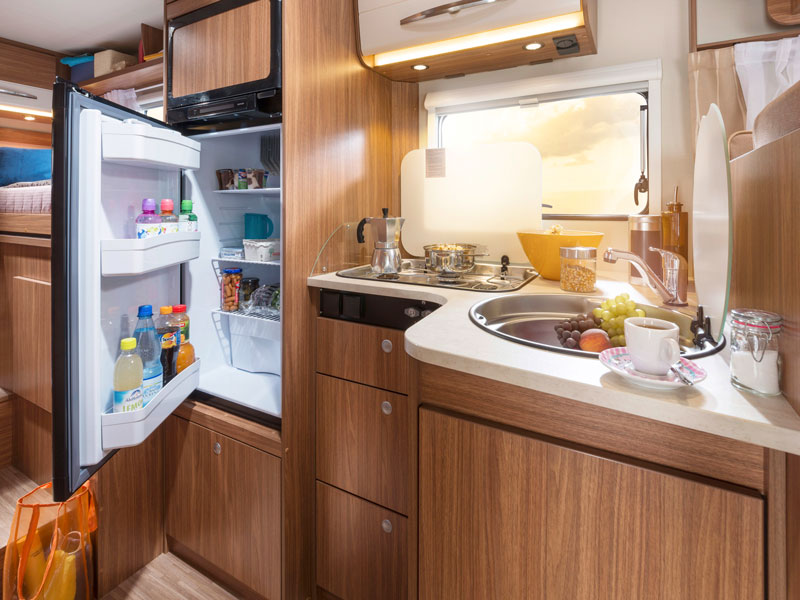There are essentially three main types of fridge—absorption, compressor, and thermo-electric. Each has their pros and cons and each varies in its function.
Absorption fridges
An absorption fridge (also known as a three-way fridge) uses ammonia as its refrigerant. These fridges are a good option for freedom camping, as they can run for an extended period of time. However, they are more expensive to install and are considerably less efficient when the temperature is more than 35°C.
Compressor fridges
A compressor fridge uses a refrigerant gas such as R134 or isobutene and works on pressure difference. They’re cheaper to install and can be used in any climate, however, because they run on battery power, compressor fridges are not ideal for freedom camping.
Thermo-electric fridges
Thermo-electric fridges are only used for temporary cooling. This is because they’re only capable of holding the ambient temperature of the contents rather than actively reducing the temperature of the items. They’re certainly cost-effective but use a lot of power and can’t cool efficiently at temperatures above 25°C.
What do I need to consider when choosing a fridge for my motorhome/caravan?
Size is the key factor. You want to accommodate for all your needs, which means you have to consider things such as storage space or other extras such as microwaves and ovens versus fridge and freezer space.
You need to consider facts such as noise level or freedom camping capabilities when making your decision. Another key factor is what type of fridge you want, for example, a three-way fridge, compressor, or thermo-electric.
Having a three-way fridge is great and has advantages but it also means that you need all three power sources available at the fridge. The 230V electrics have to be done by a certified electrician and you will have to renew your electrical warrant to assure your vehicle is still safe and compliant. The gas connection has to be installed by a certified gas fitter, and again, this has to be certified so you should factor those costs in when making your decision.
Are there any maintenance issues I should be aware of?
In general, fridges are fairly service free. You’ll need to defrost any excess ice in the freezer and remove dust from the burner assembly and electrics every couple of months, especially after driving on gravel roads.
It’s also important to keep it clean. Make sure the burner compartment on the back of the fridge is fully sealed to the interior if you’re using a fridge with gas as the energy source. The burning gas causes carbon monoxide, which could be fatal when vented into the motorhome or caravan. It needs good airflow on the back for the condenser, coils, and exhaust. Also, make sure you keep the area clear and do not store anything in the fridge cabinet.
Can I install the fridge myself?
The only fridge you can install all by yourself would be a 12V fridge. All others require a gasfitter and/or electrician to do the work for your own safety. Incorrect installation can cause serious harm to people and the vehicle.
For all other fridges, you can install the fridge and connect the 12V but leave gas fittings and 230V electrics for the experts. Be sure to secure the fridge properly so it can’t rattle free and move out of its spot.
How long should I expect my fridge to keep cool?
Compressor fridges can last from one to three days on battery power, depending on your battery setup. Absorber fridges can last several weeks and are only limited by the gas supply.
Do I need to make sure my motorhome is level when using my fridge? Why?
If you have a compressor fridge, then it is not a major consideration, as it will still work up to around 30° lean, front to back.
Absorber fridges don’t tolerate being out of level. Small variances front to back and even smaller tolerances side to side can affect the cooling. This is because the fluid will not be able to circulate properly if the fridge is tilted. For maximum fridge performance, use a spirit level and levelling blocks to keep the vehicle level when camping.
Do you have any tips on how to run my fridge efficiently?
Make sure you’re using the temperature regulator and only cool the fridge to the temperature you need instead of running on maximum the whole time.
Don’t put any warm food or drinks into the fridge and make sure your battery level never falls below 12V and that you have enough gas in your cylinders.
Check your fridge and freezer seal to make sure it is still in good condition. Also do not open the door longer than necessary.
What’s the best way to cool my fridge quickly so I can use it soon?
Turn it on the highest setting, ensure all doors are shut tightly, and avoid opening them. Ideally, you want to have the fridge nice and cool before you load it. To make it even quicker, you could assist by placing some ice in a cooler bag or plastic bottle in the fridge.






